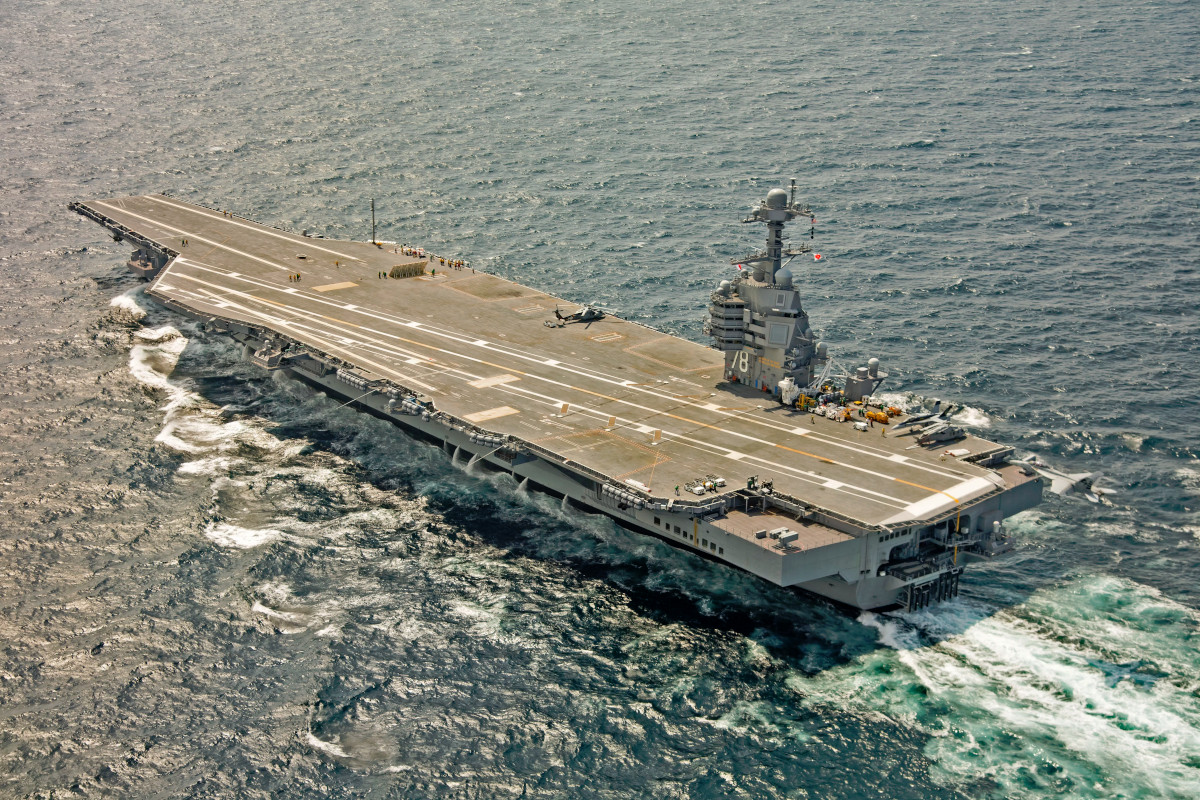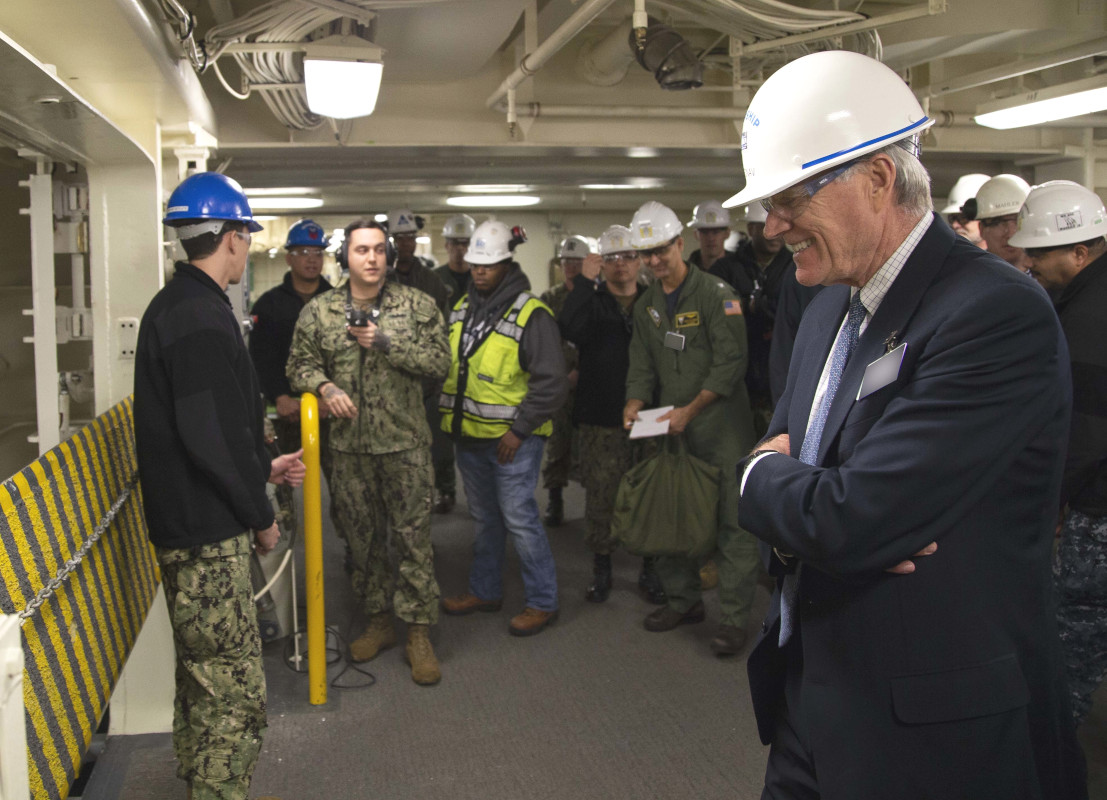Secretary of the Navy Richard Spencer berated critics of the progress, or lack thereof, on the service’s newest aircraft carrier, the first-in-class USS Gerald R. Ford, yesterday. He decried comments from Congress earlier in the week as particularly “disparaging” and tantamount to a “disinformation program” benefiting America’s opponents. This is a far cry from the “the buck stops here” tone Spencer had struck in January, when he said that President Donald Trump should fire him if any of the carrier’s advanced weapons elevators, or AWEs, were not working when the ship leaves its latest maintenance availability, something that will almost certainly be the case now.
The Navy’s top civilian official made these remarks during an event that the Brookings Institution think tank in Washington, D.C. hosted on Oct. 23, 2019. This followed a particularly tense hearing for senior naval officers in front of the House Armed Services Committee’s subcommittee on readiness the day before. Representative Elaine Luria, a Democrat from Virginia and Navy veteran who once served as the executive officer on a guided-missile cruiser, had revealed the possibility that Ford might not make her for operational deployment until 2024, six years later than originally scheduled and three years beyond the most recent public estimate, according to USNI News. She also derided the long-troubled ship in its present form as nothing more than a “$13-billion nuclear-powered floating berthing barge.”
“I look at her and other leadership on the Hill that continually disparage the Ford as a program, and I get a little upset,” Spencer said in response. “You could not ask for a better disinformation program for our competitors. And I truly mean that.”
“Not one of her comments was, ‘How can I help?'” he continued. “I have an extra seat up there when I testify, and I have not seen Huntington Ingalls, Newport News called up on the Hill to testify,” he added, referring to the company and its subsidiary responsible for designing and building the Ford, respectively.

Spencer also lambasted Congress for putting a $12.9 billion cost cap on work on the Ford, which Navy officials acknowledged they would exceed last year, and for the use of so-called continuing resolutions, or temporary spending packages, rather than full annual budgets. He complained that these factors had limited the Navy’s ability to plan ahead and take correct steps earlier, creating additional problems and delays. He specifically cited a lack of funds to build a land-based test version of the AWE to help work out problems with that particular system.
The AWE has been the latest in a string of sore spots for the Ford, which you can read about in more detail in this past War Zone piece. At present, only three of the 11 elevators on the carrier work and a fourth may be ready before she leaves the shipyard after her latest round of maintenance. Spencer famously said in January 2019 that he had told President Trump he should be fired if this were to occur.

The Navy has said that it hopes to get the remaining seven elevators certified for use within the next 18 months, meaning that work would be complete sometime in mid-2021. There continue to be concerns about the functionality and reliability of the ship’s Electromagnetic Aircraft Launch System (EMALS) catapults, electrically-controlled Advanced Arresting Gear (AAG), and radar, as well.
“Spring of this year HII [Huntington Ingalls Industries] management says ‘oops, it’s going to be 2020; we don’t really have any idea what we’re doing,’” Spencer said. “Little change in plan. Totally realize it.”

While Spencer did acknowledge that the Navy bore some of the responsibility for how the issues with Ford, his remaining criticisms seem disingenuous. For one, he completely ignored Luria’s comments from the hearing where she implored the Naval officers in attendance to tell legislators what they need to help get the carrier fixed.
“We want to be here for readiness to provide you the tools to get the carriers out to deploy on time,” she had said. “What else do you need to do that?”

Pointing the finger at Huntington Ingalls and Newport News also seems somewhat hypocritical given that, in 2007, two years before construction on Ford began, representatives from the shipyard joined the Government Accountability Office (GAO) in saying that the Navy’s cost and schedule estimates were unrealistic. The Navy pushed ahead anyways using a practice known as concurrency, wherein Newport News would begin building the ship before various key components, including the AWEs, EMALS, AAG, and radar, were anywhere near mature and their designs stable.
GAO and Newport News’ original views on concurrency and cost estimates have turned out to be entirely correct and, by 2015, Ford‘s pricetag was already exactly where Congressional watchdog and the shipyard had said it would be. This has now ballooned further due to the ongoing need to make extensive modifications to the carrier to ensure systems that are absolutely essential for it to perform its naval aviation mission work as intended.
To be fair, these decisions predate Spencer’s tenure and the impact of continuing resolutions on future program planning has been very real. Still, framing the temporary funding and Congress’ cost cap on Ford, nearly $3 billion more than what the Navy said the carrier would cost in total more than a decade ago, as the real driver in subsequent delays ignores the reality that the concurrency process created many of the underlying issues in the first place, either.

For instance, there would have been no need to build a land-based AWE test article had the design of the elevators, as well as where they would go on the ship itself, been mature when construction started. As of July 2019, up to 70 elevator doors and 17 elevator hatches associated with the AWEs simply did not work because of how the ship’s structure had grown and changed around them physically over time, adding protrusions that meant they could not open or be accessed properly in some cases, according to Bloomberg.
“It is important to note that the evolution of many of the new technologies on Ford were originally to be implemented over the first three ships of the class,” Huntington Ingalls pointed out in a statement to USNI News in response to Spencer’s criticisms, a clear reference to concurrency. “That plan was changed in 2002, when a decision was made to install all of the new technology on the first ship. … Most things have gone very well. Some of the newer technologies have been more challenging than anticipated. This is to be expected on any first-in-class ship.”
Beyond all this, it is the Navy’s responsibility to monitor the performance of contractors in its employ and take actions as appropriate if they fail to meet those obligations. Spencer had implicitly acknowledged this oversight role when he had previously said that President Trump should hold him personally accountable over the elevator issues.
“Here are the facts: The USS Ford will be six years delayed in its initial deployment, which causes incredible strain on the carrier fleet,” Representative Luria shot back in her own statement. “It is now fall, and no elevators accessing the ammunition storage areas are functioning, which results in a carrier with no combat capability. I have yet to see a detailed plan to fix the multitude of problems with these new technologies.”

The continuing troubles with Ford also come at a time when the Navy is experiencing a worrying shortage of available carriers, a scenario that the service has been warning about and attempting to find ways to mitigate for years. As it stands now, the USS Abraham Lincoln looks set to remain on station in the Middle East longer than intended after during a confluence of factors, most recently an electrical system mishap that sidelined the USS Harry S. Truman and prevented her from deploying on schedule.
“If you talk to HII, they’ll tell you it’s a trail of tears,” Spencer said. “Well, you know what, we have to get the thing off the pier and out to sea.”
He’s not wrong about how important it is to ensure that Ford is truly ready to begin conducting operations as soon as possible. However, it remains to be seen how many delays will persist, regardless, due to various decisions that the Navy made about the design and construction of the carrier, to begin with.
Contact the author: joe@thedrive.com
